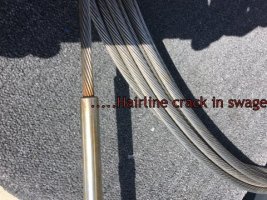Oversizing the rigging Headstay size for furler.
The furler sizes are generally a maximum recommended stay size, not a you must have this size recommendation. The 8mm corresponds to the alternate measurement system about 9/32. I have not run into any of them that would not be fine with either an 8mm or a 9/32 wire if that is the size they are specked for.
Rigging wire size is designed to safely handle the forces that your rig and boat. (Yes the hull makes a lot of difference for the rig). The size of the wire is set to match the load that your boat is likely to put on the rig under extreme circumstances. Then a safety factor is calculated, and that is the size wire rope that is used. The safety factor is normally about 5:1. This safety factor is much misunderstood by a lot of people, including some riggers. (The safety factor has nothing to do with the idea that the rig will age. The rig should always have a 5:1 safety factor. As that wire gets older and work hardens and corrodes, it frequently is a lot less than 5:1. Which can result all too fast into the mast sharing the cockpit with the crew.)
The safety factor is there because we can't accurately model reality with mathematical equations and human assigned numbers for variables. For instance, what happens when the boat falls of a 3 foot wave just as a gust of wind strikes the sails. There is a lot of modeling that would have to be done there to calculate what the load would be on say your aft lower port shroud, (port aft d1 for those that want to speak modern rigging). So through a lot of trial and error in the past, and quite a few dead people, we arrived at the idea that we need about a 5:1 safety factor so that the mast does not fall down. The boat design is then finished allowing for the size of the wire that gives us that 5:1 safety factor. The chain plates are correctly sized, out of the correct material, with the correct fasteners, and the correct size pin holes in them. They are glassed to the hull with the correct schedule of layup to support the load on the chain plates, etc... All the way down through the keel bolts and the mast step.
Now if you for some reason think... Hey if 5:1 is good, then what if I double the wire size and have a 10:1 safety factor, after all I live in America, and bigger is always better right!? Errr no... That wire is going to be a lot heavier, and the boat is going to sail a lot worse because of it, then that added weight adds a lot more loading to the entire rig from that mast step, all the way through the spreaders to that tippy top tang on the cap shrouds (Vx/Dx for those trying to speak modern rigging words). Then add to the fact that if you are using SS wire rope, those shrouds have to be tuned at a minimum of 10% of their breaking strength to not work harden and break, and you can see that even if you were to drill out the chain plates for the larger pin size needed (Which would of course weaken the chain plate connection because they were no designed to be drilled out), you would now have at least twice the static load on the rig and chain plates before we even started trying to tune it. And down through those fasteners and layup etc. So instead of a larger safety factor, you are now overloading the structure and have a significantly smaller safety factor!
Once we start trying to tune it, we run into even bigger problems. In tuning the forces on the rig, and the forces generated by the rigging all balance out. Changing the forces genereated by the rigging alters the tuning, in most cases making a good tune impossible if the previous owner has decided to up-size the rig.
Guy



